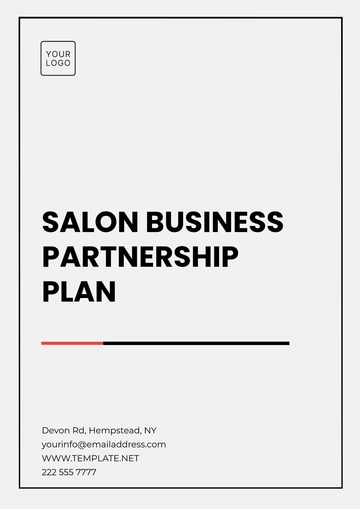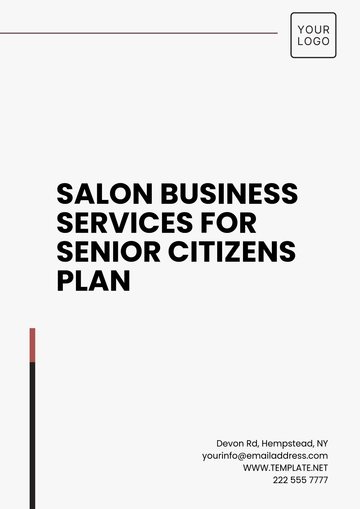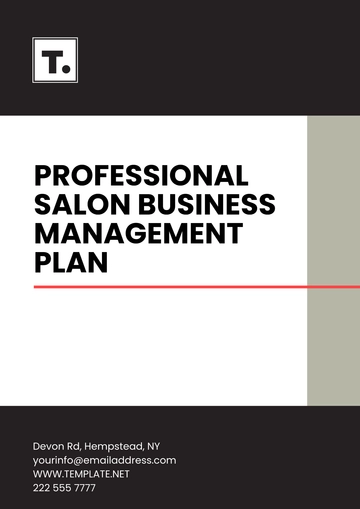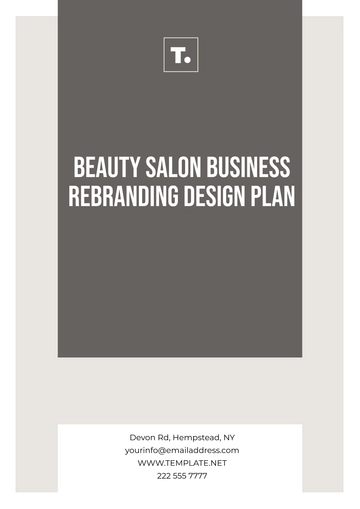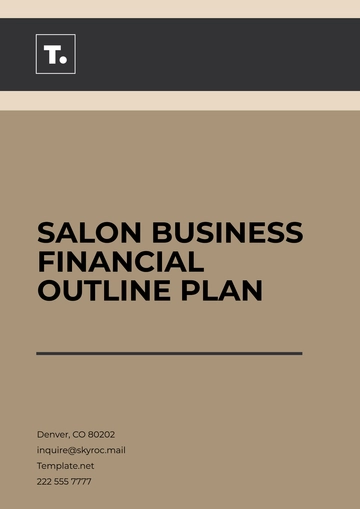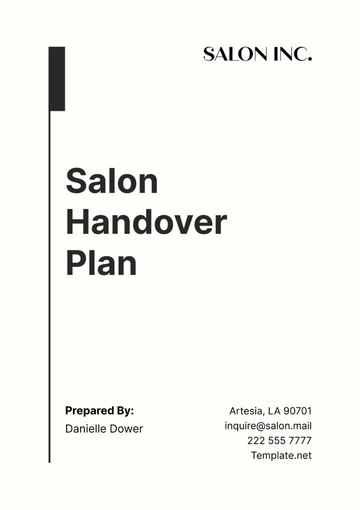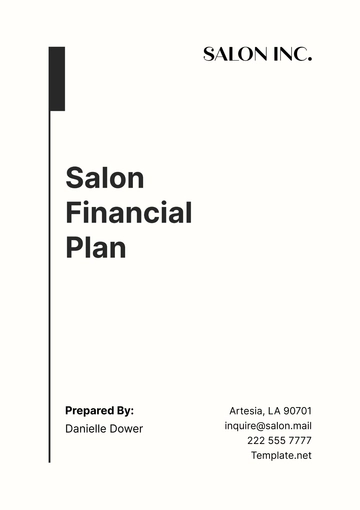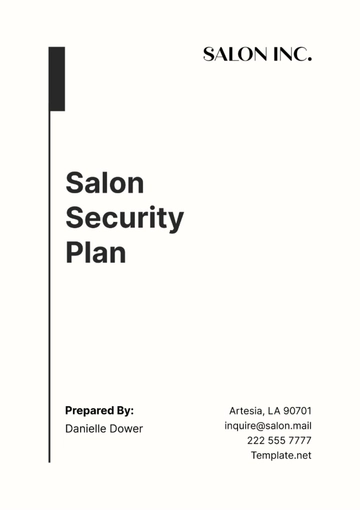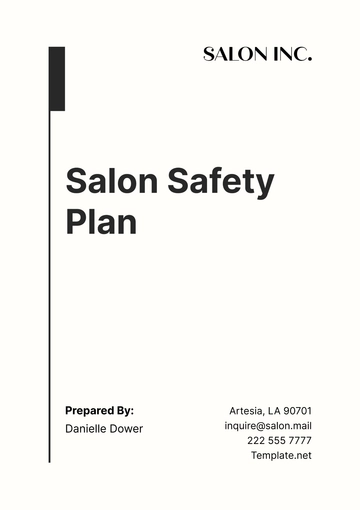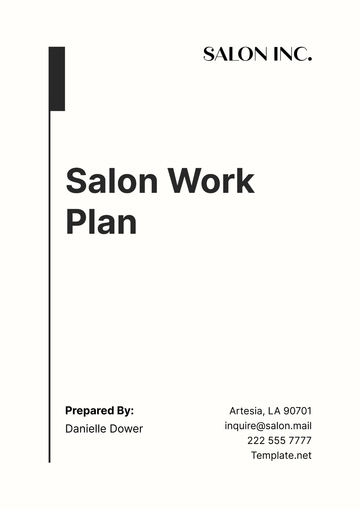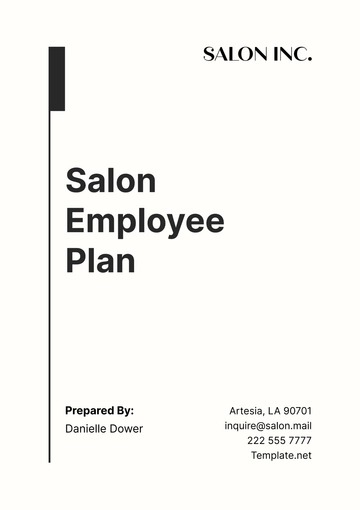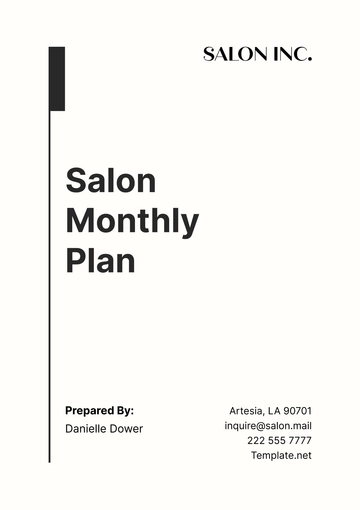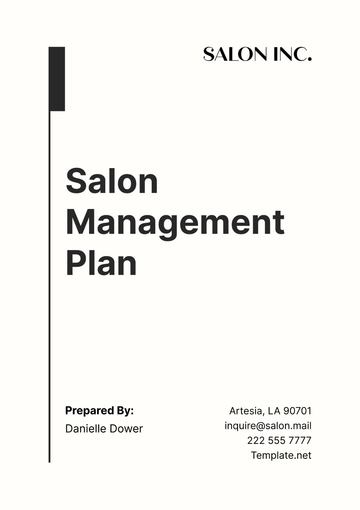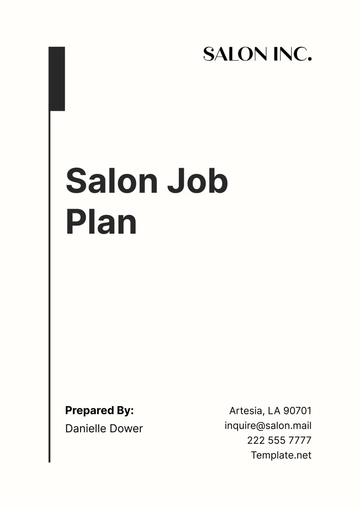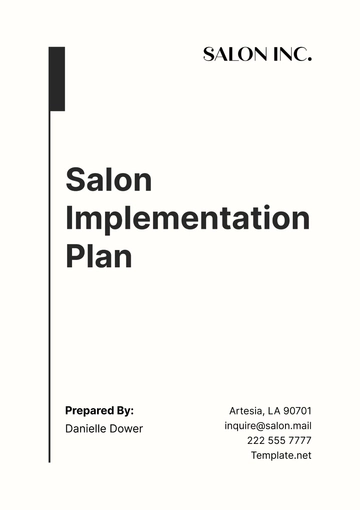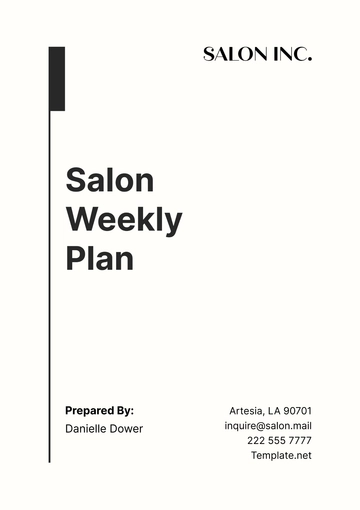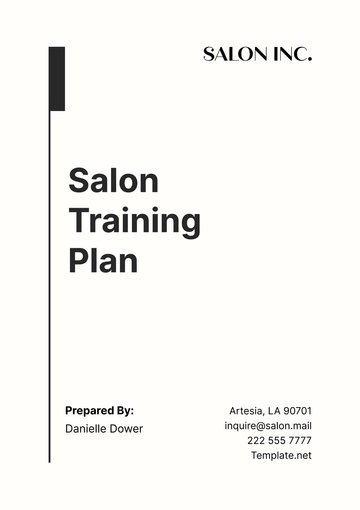Free Salon Training Plan
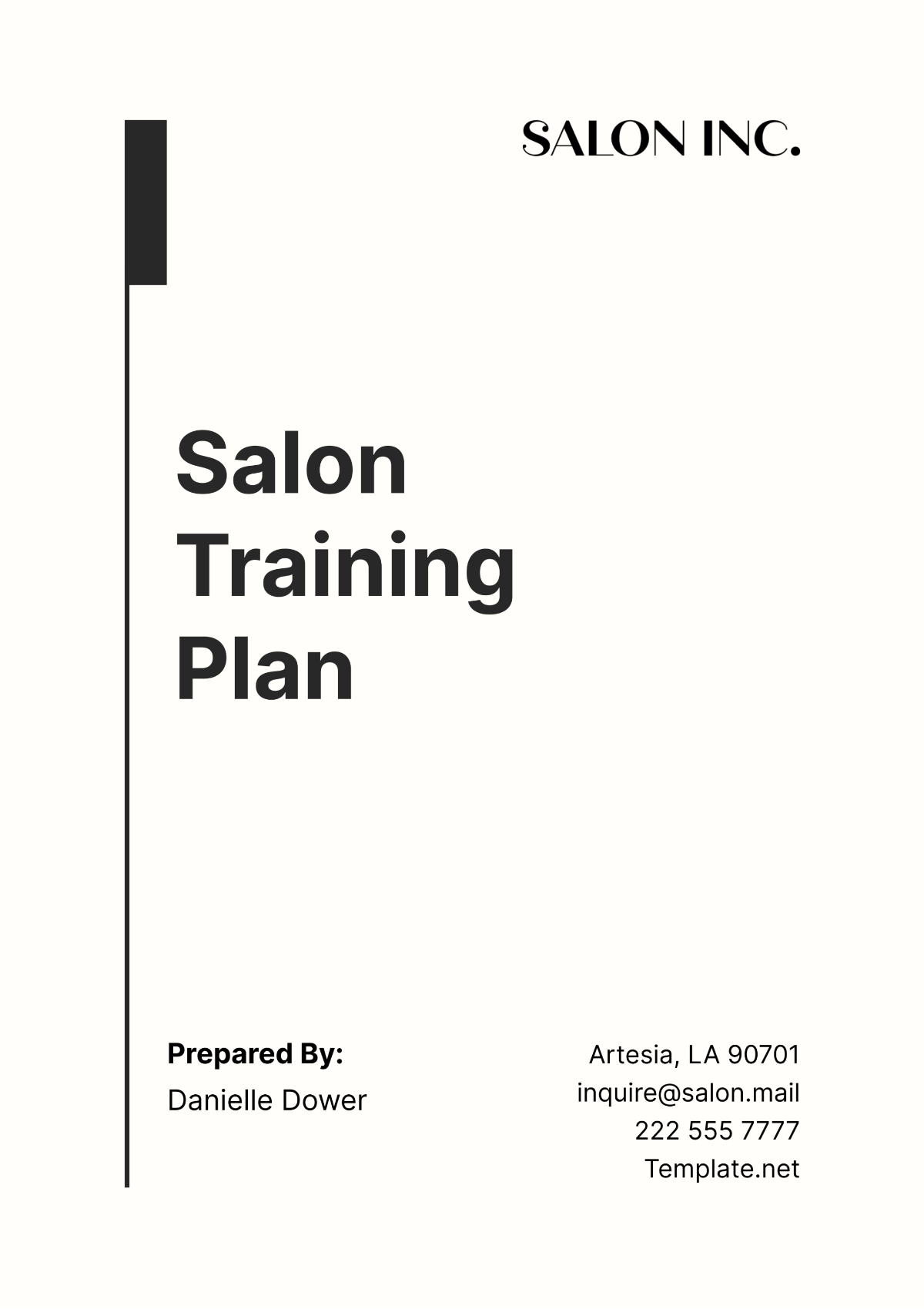
1. Introduction
Purpose of the Training Plan
The purpose of this training plan is to enhance the professional skills and knowledge of all employees at [Your Company Name], ensuring they are equipped to provide the highest standard of service. This plan is designed to address the evolving needs of our clients and the dynamic trends of the beauty industry.
Objectives and Expected Outcomes
Improve technical skills in cutting, coloring, and styling.
Enhance customer service skills, focusing on communication and client satisfaction.
Increase product knowledge to better advise clients and boost product sales.
Ensure compliance with health and safety regulations.
Overview of Training Topics and Schedules
The training program will cover a range of topics, from technical skills to business management. Sessions are scheduled quarterly to ensure all staff receive continuous professional development. The training is mandatory for all new hires and current staff.
2. Assessment of Training Needs
Identification of Skill Gaps
Skill gaps are identified through:
Performance reviews
Client feedback
Supervisory observations
A detailed analysis of these sources will help pinpoint specific areas where improvement is needed, be it technical skills or customer service.
Staff Surveys and Feedback
All staff members are encouraged to participate in a confidential survey to express their training needs and interests. The survey includes questions about their current job challenges, areas of interest for professional development, and preferences for learning formats.
Review of Industry Trends and New Technologies
Staying current with industry trends is vital. This includes new styling techniques, emerging beauty products, and advancements in salon equipment. Regular attendance at industry conferences and trade shows, along with subscriptions to professional publications, keeps our curriculum relevant and forward-thinking.
3. Training Program Design
Curriculum Development
The curriculum is designed to cater to various roles within the salon, ensuring that each staff member receives training tailored to their specific duties and responsibilities.
Role | Key Focus Areas |
|---|---|
Stylists | Cutting, coloring, and styling techniques |
Colorists | Advanced color theory, application methods |
Receptionists | Customer service, booking systems |
Selection of Training Methods
A variety of training methods are utilized to cater to different learning styles and to ensure a comprehensive understanding of the material.
Method | Description |
|---|---|
Hands-on | Practical application at salon stations |
Theoretical | Classroom-style lectures on theory |
Online Modules | Interactive courses accessible remotely |
Duration and Frequency of Training Sessions
Training sessions are structured as follows:
Training Type | Duration | Frequency |
|---|---|---|
Full Courses | 2 weeks | Annually |
Workshops | 1 day | Quarterly |
Online Modules | Self-paced | Ongoing |
4. Training Topics
Technical Skills
Technical skills are crucial for all practical roles within the salon. The following areas are emphasized:
Skill Category | Specific Topics |
|---|---|
Hair Cutting | Latest trends, classic cuts |
Coloring | Techniques, safety, color theory |
Styling | Updos, bridal, everyday looks |
Customer Service Skills
Excellent customer service is key to client retention and satisfaction. Training focuses on:
Skill | Description |
|---|---|
Communication | Effective listening, empathy, clarity |
Complaint Handling | Resolution techniques, de-escalation |
Upselling | Identifying opportunities, soft skills |
Product Knowledge
Staff should be knowledgeable about all products used and sold in the salon.
Area | Details |
|---|---|
Usage | Correct application, benefits |
Safety | Allergen information, contraindications |
Sales | Features that meet client needs |
Health and Safety
Maintaining a safe and healthy workplace is non-negotiable.
Focus Area | Components |
|---|---|
Sanitation | Sterilization techniques, workstation cleanliness |
Workplace Safety | Emergency procedures, equipment handling |
Compliance | Local health regulations, salon standards |
5. Implementation of the Training Program
Scheduling Training Sessions
Training sessions are planned in advance to ensure minimal disruption to salon operations. A yearly training calendar is provided to all staff.
Quarter | Focus |
|---|---|
Q1 | Technical Skills |
Q2 | Customer Service |
Q3 | Product Knowledge |
Q4 | Health and Safety |
Allocating Resources
Resources are allocated based on the specific needs of each training module.
Resource | Use |
|---|---|
Instructors | Expert trainers from within and outside the salon |
Materials | Manuals, online resources, practice supplies |
Venues | In-salon for hands-on, rented spaces for larger groups |
Communication Plan
A detailed communication plan ensures that all staff members are informed about upcoming training sessions, expectations, and any preparations they need to make.
Method | Details |
|---|---|
Monthly newsletters, reminders | |
Meetings | Regular staff meetings to discuss schedules |
Notice Boards | Updates and schedules are posted in common areas |
6. Training Delivery
Effective training delivery is crucial to the success of our training program at [Your Company Name]. It ensures that the content is not only delivered but also absorbed and applied effectively by all team members.
In-house Trainers vs. External Experts
We employ a blend of in-house trainers and external experts to deliver training sessions. In-house trainers offer a deep understanding of our company culture and client expectations, while external experts bring specialized knowledge and fresh perspectives, especially useful in areas like advanced coloring techniques and emerging beauty technologies.
Training Delivery Methods:
In-House Trainers: Focus on customer service, basic styling, and product knowledge.
External Experts: Brought in for specialized workshops on topics such as advanced hair-cutting techniques and new styling tools.
Use of Technology
Technology plays a significant role in our training delivery:
Virtual Reality (VR): Used for immersive learning experiences, especially for complex styling and color techniques.
Video Tutorials: Regularly updated and available on our internal portal for ongoing learning.
Online Platforms: Utilized for theory modules, allowing staff to learn at their own pace with quizzes and interactive content.
Practical Sessions and Role-Playing Scenarios
Hands-on practice is a cornerstone of our training methodology. Each training module includes practical sessions where staff can apply what they've learned on mannequins or volunteer models. Role-playing scenarios are particularly used for training in customer service, helping staff practice and refine their communication and problem-solving skills in a controlled, supportive environment.
Example Practical Session Plan:
Session: Advanced Coloring Techniques
Activity: Applying balayage on a model under expert supervision
Feedback: Immediate constructive feedback from trainers
7. Evaluation and Feedback
To ensure the training program meets its objectives and contributes to the overall success of the salon, we implement a robust system of evaluation and feedback.
Methods for Assessing the Effectiveness of Training
Tests and Practical Exams: Conducted at the end of each module to assess knowledge retention and practical application.
Feedback Forms: Distributed after every session to gather participant feedback on the training experience and the instructor's effectiveness.
Performance Metrics: Post-training performance is monitored through client feedback, repeat business, and product sales metrics to gauge the real-world application of skills learned.
Evaluation Tools:
Online Surveys: For immediate post-training feedback.
Follow-Up Assessments: Conducted 30 days post-training to evaluate long-term retention and application.
Annual Reviews: Incorporate training effectiveness as a component of annual performance reviews.
Gathering Feedback from Participants
Feedback is essential not only immediately following training sessions but also as part of an ongoing dialogue about professional development. This feedback informs future training content and methodologies, ensuring they remain relevant and effective.
Feedback Collection Example:
Method: Digital feedback forms
Questions: Rate the trainer’s clarity, the usefulness of the material, and the applicability of the skills learned.
Adjustments Based on Feedback and Results
Feedback leads to adjustments in training approaches, schedules, and content. For instance, if feedback indicates a desire for more hands-on time with clients, future sessions may be adjusted to increase practical experience.
8. Follow-up and Continuous Learning
Continual learning and development are key pillars in maintaining high standards of professionalism at [Your Company Name] and keeping pace with the rapidly evolving beauty industry.
Scheduled Refresher Courses
Refresher courses are scheduled not only to reinforce previously learned skills but also to introduce new techniques and products that have entered the market. These courses are integral in helping staff adapt to new trends and technologies, ensuring that our services remain competitive and cutting-edge. Regularly scheduled refreshers also prevent skill decay and promote a high standard of workmanship across all staff members.
Ongoing Support and Resources
To support ongoing learning, [Your Company Name] provides access to a dedicated training coordinator who is available to help staff with any questions or further learning needs they might have post-training. This role is critical in bridging the gap between formal training events and day-to-day practice, ensuring that staff feel supported in their continuous professional development. Additionally, monthly skill workshops are offered, allowing staff to focus on particular areas of interest or challenge.
Integration of Learning into Daily Routines and Practices
Beyond structured training sessions and resources, [Your Company Name] encourages a culture of peer learning and mentorship. Senior staff are paired with newer employees in a mentorship program that promotes the sharing of knowledge and feedback in real-time during salon hours. This hands-on learning approach is invaluable as it enables less experienced stylists to learn directly from their more seasoned colleagues, fostering a team-oriented environment where everyone is committed to collective success.
9. Documentation and Records
Accurate documentation and records are vital for monitoring the effectiveness of the training program and ensuring compliance with industry standards.
Recording Attendance and Participant Progress
Detailed records of attendance and progress are essential for tracking the professional development of each staff member and identifying trends in training engagement and effectiveness. These records help management to understand the impact of training on individual performance and to tailor future sessions to better meet the needs of the team. For instance, tracking progress over multiple sessions can highlight areas where the curriculum may need to be adjusted to address persistent challenges.
Certifications and Qualifications Achieved
Recording certifications and qualifications is crucial not only for compliance and career progression but also for motivating staff. Celebrating these achievements boosts morale and encourages a lifelong learning mindset among team members. It also helps in marketing our salon's expertise to potential clients, showcasing our commitment to high standards and professional development.
Compliance with Local and Industry-specific Training Requirements
Keeping detailed records of compliance with training requirements is mandatory for legal and operational reasons. Regular audits of these records ensure that the salon remains compliant with all local laws and regulations, protecting the business and its clients from potential legal issues. These records also serve as proof of our dedication to maintaining the highest standards of safety and professionalism, which is essential for building trust with new and returning clients.
10. Conclusion
Summary of Training Program Impact
The training program at [Your Company Name] has significantly improved our service quality, increased client satisfaction, and enhanced staff morale and competence. The investment in continuous professional development reflects our competitive positioning in the market and our financial results.
Future Training Plans and Objectives
We plan to expand our training program to include international beauty trends and potentially host guest trainers from renowned global salons. Additionally, we aim to incorporate more advanced technology-based learning aids, such as augmented reality, to further enhance training effectiveness.
Final Remarks and Encouragement for Ongoing Development
At [Your Company Name], we believe in the power of education and continuous improvement. We are committed to supporting every team member in their professional journey, encouraging them to embrace lifelong learning as a pathway to personal and professional fulfillment.
- 100% Customizable, free editor
- Access 1 Million+ Templates, photo’s & graphics
- Download or share as a template
- Click and replace photos, graphics, text, backgrounds
- Resize, crop, AI write & more
- Access advanced editor
Elevate your team's expertise with Template.net's Salon Training Plan Template. Fully customizable and editable via our AI Editor Tool, this template provides structured formats for developing effective training programs, enhancing skills, and boosting performance. Ideal for salons focused on continuous improvement and excellence in service delivery.
You may also like
- Finance Plan
- Construction Plan
- Sales Plan
- Development Plan
- Career Plan
- Budget Plan
- HR Plan
- Education Plan
- Transition Plan
- Work Plan
- Training Plan
- Communication Plan
- Operation Plan
- Health And Safety Plan
- Strategy Plan
- Professional Development Plan
- Advertising Plan
- Risk Management Plan
- Restaurant Plan
- School Plan
- Nursing Home Patient Care Plan
- Nursing Care Plan
- Plan Event
- Startup Plan
- Social Media Plan
- Staffing Plan
- Annual Plan
- Content Plan
- Payment Plan
- Implementation Plan
- Hotel Plan
- Workout Plan
- Accounting Plan
- Campaign Plan
- Essay Plan
- 30 60 90 Day Plan
- Research Plan
- Recruitment Plan
- 90 Day Plan
- Quarterly Plan
- Emergency Plan
- 5 Year Plan
- Gym Plan
- Personal Plan
- IT and Software Plan
- Treatment Plan
- Real Estate Plan
- Law Firm Plan
- Healthcare Plan
- Improvement Plan
- Media Plan
- 5 Year Business Plan
- Learning Plan
- Marketing Campaign Plan
- Travel Agency Plan
- Cleaning Services Plan
- Interior Design Plan
- Performance Plan
- PR Plan
- Birth Plan
- Life Plan
- SEO Plan
- Disaster Recovery Plan
- Continuity Plan
- Launch Plan
- Legal Plan
- Behavior Plan
- Performance Improvement Plan
- Salon Plan
- Security Plan
- Security Management Plan
- Employee Development Plan
- Quality Plan
- Service Improvement Plan
- Growth Plan
- Incident Response Plan
- Basketball Plan
- Emergency Action Plan
- Product Launch Plan
- Spa Plan
- Employee Training Plan
- Data Analysis Plan
- Employee Action Plan
- Territory Plan
- Audit Plan
- Classroom Plan
- Activity Plan
- Parenting Plan
- Care Plan
- Project Execution Plan
- Exercise Plan
- Internship Plan
- Software Development Plan
- Continuous Improvement Plan
- Leave Plan
- 90 Day Sales Plan
- Advertising Agency Plan
- Employee Transition Plan
- Smart Action Plan
- Workplace Safety Plan
- Behavior Change Plan
- Contingency Plan
- Continuity of Operations Plan
- Health Plan
- Quality Control Plan
- Self Plan
- Sports Development Plan
- Change Management Plan
- Ecommerce Plan
- Personal Financial Plan
- Process Improvement Plan
- 30-60-90 Day Sales Plan
- Crisis Management Plan
- Engagement Plan
- Execution Plan
- Pandemic Plan
- Quality Assurance Plan
- Service Continuity Plan
- Agile Project Plan
- Fundraising Plan
- Job Transition Plan
- Asset Maintenance Plan
- Maintenance Plan
- Software Test Plan
- Staff Training and Development Plan
- 3 Year Plan
- Brand Activation Plan
- Release Plan
- Resource Plan
- Risk Mitigation Plan
- Teacher Plan
- 30 60 90 Day Plan for New Manager
- Food Safety Plan
- Food Truck Plan
- Hiring Plan
- Quality Management Plan
- Wellness Plan
- Behavior Intervention Plan
- Bonus Plan
- Investment Plan
- Maternity Leave Plan
- Pandemic Response Plan
- Succession Planning
- Coaching Plan
- Configuration Management Plan
- Remote Work Plan
- Self Care Plan
- Teaching Plan
- 100-Day Plan
- HACCP Plan
- Student Plan
- Sustainability Plan
- 30 60 90 Day Plan for Interview
- Access Plan
- Site Specific Safety Plan
